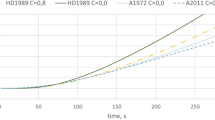Abstract
Automatic sprinklers are increasingly used in residential occupancies to provide active fire protection. These sprinklers, known as quick response and residential sprinklers, may be located either at the ceiling (pendent-style) or on a wall (sidewall-style). Though several fire models are available for estimating actuation times for sprinklers located under unobstructed ceilings, these use engineering correlations that do not apply to residential-sized rooms. Thus, data are needed for estimating sprinkler actuation times for residential occupancies.
This paper reports on fire tests that were conducted in various sized rooms to obtain temperature and velocity data for 73 kW, 100 kW, and 147 kW fires. The data were then used to develop nondimensional correlations for temperature and velocity at the sprinkler locations. The temperature data revealed a significant temperature transient in the hot gas layer, and thus a nondimensional correlation describing the transient phenomenon was developed. These correlations compared reasonably well with experimental data, and they were used to estimate the sprinkler actuation times. The estimates were in reasonable agreement for the pendent sprinkler, except for the smallest fire in a 4.27 m by 4.27 m occupancy. The estimates for sidewall sprinkler acuation were significantly lower than experimental values. This may have been due to the sprinklers' heat losses, which were not accounted for in the calculation.
Similar content being viewed by others
References
Heskestad, G., and Smith, H. F., “Investigation of a New Sprinkler Sensitivity Approval Test: The Plunge Test,”FMRC 22485, Factory Mutual Research Corporation, Norwood, Mass., December 1976.
UL199,Standard for Automatic Sprinklers for Fire Protection Service, 8th Edition, Underwriters Laboratories Incorporated, Northbrook, Ill.
Alpert, R.L., “Calculations of Response Time of Ceiling-Mounted Fire Detectors,”Fire Technology Volume 8, 1972, pp. 181 to 195.
Stroup, D. W., and Evans, D. D., “Methods to Calculate the Response Time of Heat and Smoke Detectors Installed Below Large Unobstructed Ceilings,”NBSIR85-3167, National Bureau of Standards (now NIST), Center for Fire Research, Gaithersburg, Md., 1985.
Davis, W. D., and Cooper, L. Y., “A Computer Model for Estimating the Response Time of Sprinkler Links to Compartment Fires with Draft Curtains and Fusible Actuated Ceiling Vents,”Fire Technology Volume 27, 1991, pp. 113 to 127.
Quintiere, J. G., McCaffrey, B. J., and Kashiwagi, T., “A Scaling Study of a Corridor Subject to a Room Fire,”Combustion Science and Technology Volume 18, 1978, pp. 1 to 19.
McCaffrey, B. J., Quintiere, J. G., and Harkleroad, M. F., “Estimating Room Temperatures and the Likelihood of Flashover Using Fire Test Data Correlations,”Fire Technology, Volume 17, 1981.
Quintiere, J. G., Steckler, K., and Corley, D., “An Assessment of Fire Induced Flows in Compartments,”Fire Science and Technology, Volume 4, N1984, pp. 1 to 4.
“Final Report of Sprinkler Research,”EWR-89-3083, Federal Emergency Management Agency, U.S. Fire Administration, 1990.
The Omega Temperature Measurement Handbook and Encyclopedia, Omega Engineering, Inc., Stamford, Conn., Volume 28, 1992.
Rockett, J. A., “Fire Induced Flow in an Enclosure,”Combustion Science and Technology Volume 12, 1976, p. 165.
Cooper, L., Harkleroad, M., Quintiere, J. G., and Rinkinen, W., “An Experimental Study of Upper Hot Layer Stratification in Full-Scale Multiroom Fire Scenarios,”Transactions of the ASME, Journal of Heat Transfer Volume 104, 1982, pp. 741 to 749.
Heskestad, G., and Bill, R. G., Jr., “Quantification of Thermal Responsiveness of Automatic Sprinklers,” presented to the Fire Detection and Suppression Symposium, Society of Fire Protection Engineers, Maritime Institute of Technology, Linthicum Heights, Md., 1987.
NFPA13D,Sprinkler Systems in One- and Two-Family Dwellings and Mobile Homes National Fire Protection Association, Batterymarch Park, Quincy, Mass., 02269, 1991.
Steckler, K. D., Quintiere, J. G., and Riniken, W. J., “Flow Induced by Fire in a Compartment,”NBSIR 82-2520, U.S. Department of Commerce, National Bureau of Standards, National Engineering Laboratory, 1982.
Sako, S., and Hasemi, Y., “Response Time of Automatic Sprinklers Below a Confined Ceiling,”Fire Safety Science—Proceedings of the Second International Symposium, pp. 613 to 622.
Marks, C. H., and Motevalli, V., “Transient Characteristics of Unconfined Fire Plume Driven Ceiling Jets,”NB-GCR-87-529, National Bureau of Standards, Center for Fire Research, Gaithersburg, Md., 1987.
Heskestad, G., Bill, R. G., Jr., “Conduction Heat Loss Effects on Thermal Response of Automatic Sprinklers,”FMRC.J1.0N075.RU/0N176, Factory Mutual Research, Norwood, Mass., 1987.
Author information
Authors and Affiliations
Rights and permissions
About this article
Cite this article
Gandhi, P.D. Temperature and velocity correlations in room fires for estimating sprinkler actuation times. Fire Technol 31, 137–157 (1995). https://doi.org/10.1007/BF01040710
Issue Date:
DOI: https://doi.org/10.1007/BF01040710




